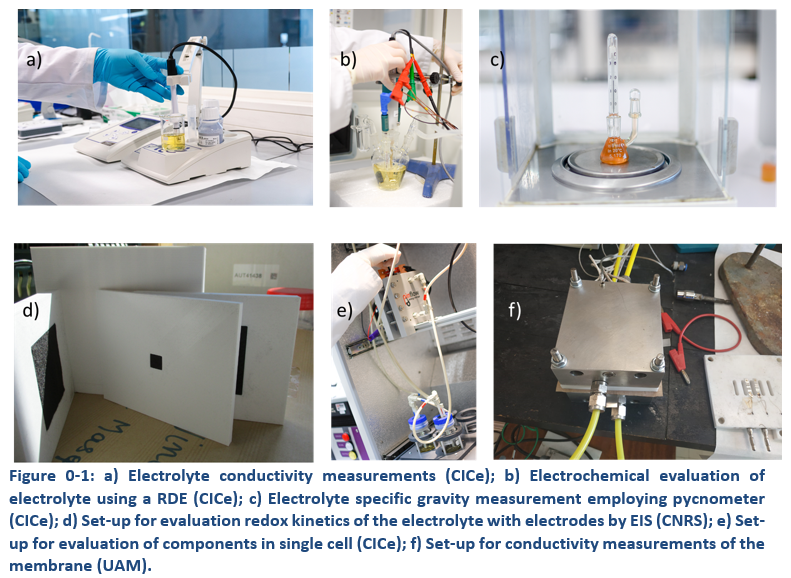Result from partners CIC energiGUNE, UAM, CNRS, UWB and PFES.
Result has been achieved on 15 September 2020 in month 11 of the project (results correspond to the work performed during months 3 to 11 for the topic 2: Materials and components optimisation)
Upon a long synthesis, characterization and evaluation process of the different key components for the battery definition (electrolyte, membrane, electrode and bipolar plates); the set of components to be implement in the HIGREEW project for testing at single cell has been pre-defined.
- Objective: to identify, synthesize and/or modify and characterize a bunch of materials to gather information on their properties and finally select the most appropriate combination of those for their evaluation at single cell prior to evaluation at stack level.
- Research: Several organic compounds have been synthesized and evaluated for their suitability as redox active materials. This includes evaluation of the electron transfer rate and reversibility of the redox process (CV, RDE) as well as evaluation of the physical-chemical properties of the electrolyte solution (conductivity, viscosity, density…). Analogously, evaluation of membranes including commercial and newly designed materials has been carried out. In addition to the required chemical characterization of new materials, characterization of membranes refers to their conductivity (EIS) and capacity as selective ion exchange materials (IEC, permeability, water uptake…). Furthermore, several carbon felts have been evaluated for their application as electrodes in redox flow batteries with organic redox active materials (EIS). Evaluation of those materials comprehends the study of activation protocols for the felts. Finally, different bipolar plates designs have been proposed and under study.
- Result: Multiple results have been obtained from this task. Most straightforward results would be the development of new relevant materials for application in redox flow batteries. The evaluation of the properties of both known and new materials has resulted in a database that includes all representative parameters. Those parameters define their suitability for application in a redox flow battery. Ultimately this information gathered serves and has served for the selection of candidates to be implemented in HIGREEW battery. Thus, new highly water-soluble redox pairs based on stable organic compounds showing good kinetics (k0 ≥ 10-2 cm/s), diffusion (D ≥ 10-6 cm2/s) and reversibility towards the redox process have been developed. Based on these materials, suitable electrolytes have been proposed (σ ≥ 50 mS/cm). In addition, membranes showing low ASR (< 1Ω/cm2) and electrodes showing good electron transfer rate and compatibility with electrolyte candidates have been identified.
- What will it be used for: Initially, selected materials will be evaluated at single cell-lab scale devices, and later on, upon validation, will be implemented in the HIGREEW stack and prototype. The information gathered from the evaluation of the materials, as defined in topic 1 Specifications definition, should serve as guidance for the design of the stack. Properties as conductivity, cell voltage, viscosity and structure or composition of the components are of critical importance.
- Impact: The impact of this work will be to provide a consolidated set of components that would be crucial to fulfil technical objectives of the project and enable good functioning of the final prototype.
